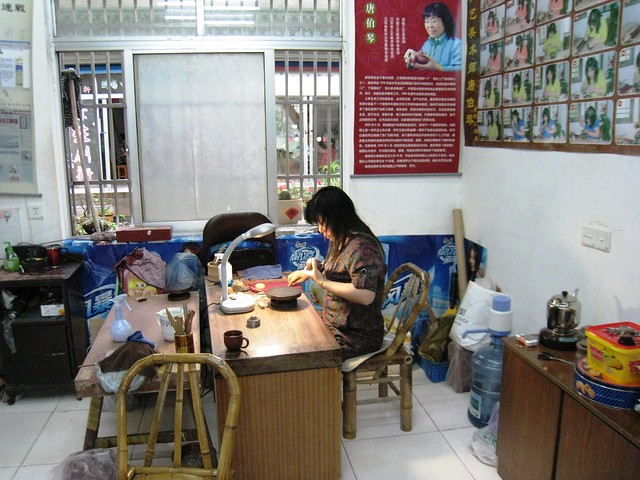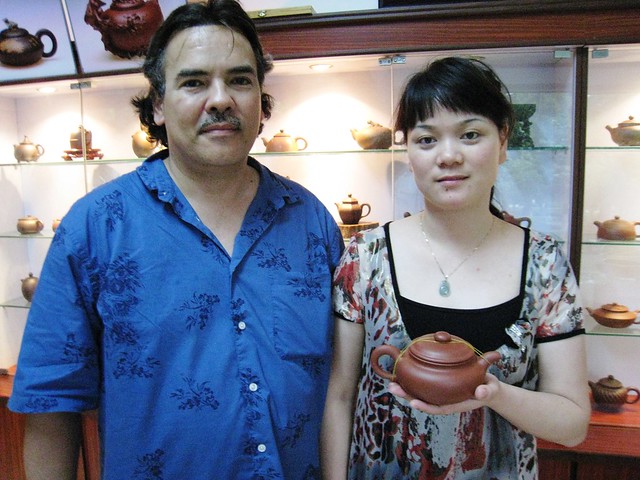











Louvre things are out there for the selected people, the range of understanding and interpretation should be pretty narrowed down, top owners of genius' pantings are the dealers, who can authenticate fake & good, and they are millionaire just because they are capable of doing that.gasninja wrote:No shame economist thanks for sharing. You can't compare your yixing collection Tim's. For most of us that would be like me comparing my four year old son''s finger painting on my refrigerator to the Louvre.
I have curious about spots as well. My new Hong ni pot has a black spot. I will post pics later.
chrl42 wrote: Louvre things are out there for the selected people, the range of understanding and interpretation should be pretty narrowed down, top owners of genius' pantings are the dealers, who can authenticate fake & good, and they are millionaire just because they are capable of doing that.
therefore, norms like us should always be careful and take minutes to think, before dredging out like topics..
what's more difficult, what's crucial is the idea and culture of east and west have a vast difference, even if one gets benefit of understanding Louvre doesn't mean the one is also capable of Chinese art or Yixing teapot.
I guess that was the privilege of era, nowadays we are living in high-tech society but being soaked up with numerous fake goods, not finding way out
kyarazen wrote:don't forget the chinese's love for making replicas. 明朝复宋,清朝复明,民国复清,等等。(simple translation : ming dynasty people made objects in song dynasty style, etc..) this is seen across all sorts of chinese art works, porcelain, pottery.
and if one thinks that he/she is smart after reading a bunch of books or studying some reference objects in museums/in collectors hands, like how Qiu Xiao Jun says, the counterfeiter or replica maker is just as smart, he probably would have read the same books, and know even more than the consumer

a recent section in a local "store" that had been selling ming jia and qing dynasty pots was pulled recently after being in business for over a decade.. i wonder why

chrl42 wrote: Louvre things are out there for the selected people, the range of understanding and interpretation should be pretty narrowed down, top owners of genius' pantings are the dealers, who can authenticate fake & good, and they are millionaire just because they are capable of doing that.
therefore, norms like us should always be careful and take minutes to think, before dredging out like topics..
what's more difficult, what's crucial is the idea and culture of east and west have a vast difference, even if one gets benefit of understanding Louvre doesn't mean the one is also capable of Chinese art or Yixing teapot.
I guess that was the privilege of era, nowadays we are living in high-tech society but being soaked up with numerous fake goods, not finding way out
A philosophy prof with whom I once studied wrote a lot about that. It was the same in the west until the Renaissance in Europe, which he disparagingly called 'The Birth of the Western Ego'. Early Medieval artists in Europe often didn't even sign their work and did much diligent copying; with the Renaissance came the glorification of the individual, idiosyncratic creativity, a sort of cult of originality and more competition, less collaboration and cooperation. Much innovation came (and comes) from that, but also much was lost I think.needaTEAcher wrote:"...In all my back and forth between East and West, this is an area where I have noticed that we simply have differing concepts of reality. The idea of replica seems to bring to Western minds shadows of "falseness" or of something being a "fake."...
In the antiquities world, there are 2 types of replicas. The first is done as an homage and is sold as such. If it is exceptional, it will fetch a higher price than one that is not as well done. Makes sense, right?needaTEAcher wrote:I just want to weigh in on this conversation here about replicas.
In all my back and forth between East and West, this is an area where I have noticed that we simply have differing concepts of reality. The idea of replica seems to bring to Western minds shadows of "falseness" or of something being a "fake".
Whereas my understanding of art and creation in China, particularly teapots, is that these replicas are closer to homage, more of a way of showing respect for tradition and working within the strict confines of what expression/creation is allowed. I think the how the West might look at a teapot and call it a fake would baffle many Chinese, sometimes even the artist/counterfeiter.
Also, reality seems to be manifold in China, with many, many "truths" that conflict and collide existing side by side. So maybe it is homage, maybe it is a counterfeit, maybe it's both simultaneously. I hope this all makes sense.
BTW, great pics squaretooth. Thanks for sharing.
Well, same as aloeswood or kyara. Chinese artist been making art replicas for a long time, the difference of making a replica art object to a commercial subject like aloeswood is to make money by cheating people than to education. Artist make replica to learn what the previous generation knows. Business people make fake to make money from unaware enthusiasts.kyarazen wrote:don't forget the chinese's love for making replicas. 明朝复宋,清朝复明,民国复清,等等。(simple translation : ming dynasty people made objects in song dynasty style, etc..) this is seen across all sorts of chinese art works, porcelain, pottery.
and if one thinks that he/she is smart after reading a bunch of books or studying some reference objects in museums/in collectors hands, like how Qiu Xiao Jun says, the counterfeiter or replica maker is just as smart, he probably would have read the same books, and know even more than the consumer

a recent section in a local "store" that had been selling ming jia and qing dynasty pots was pulled recently after being in business for over a decade.. i wonder why

heh. i used to (currently still) run an pure education website on aloeswood/agarwood/kyara. but there are some areas where i refuse to write about, and perhaps its almost time to stop writing too much in detail, its making the business people too smart. especially those in the west.TIM wrote: Well, same as aloeswood or kyara. Chinese artist being making art replicas for a long time, the difference of making a replica art object to a commercial subject like aloeswood is to make money by cheating people than to education. Artist make replica to learn what the previous generation knows. Business people make fake to make money from unaware enthusiasts.
chrl42 wrote:Authority sellers can't fool customers, if they do it's bad marking on their reputations but there are cases they sell pots twice or more pricey than other sellers. And there are authority buyers who don't do that, those sellers are usually booked with bunch of customers who are eager to buy their pots. (you can pretty much assume 'they' won't have financial problems as long as Yixing exists)
If anyone can provide, authority auctions like Bao-li or Jia-de, have sold fake goods, let me knowin my logics which is not quite possible since they are run by China-HK-Taiwan's greatest authorities.
Buying and appreciating antique Yixing is not only buying their periods, more likely it's buying their quality, it's not applied to any Chinese antiques but strictly to Yixing teapots. Hence IF Yixing replicas are equipped with good quality, it must be still buyable (if prices are ok). But the truth is it's VERY hard to get good Yixing replicas as well (these days), the reason I already stated in earlier post.
How to anthenticate Yixing fake & good.....seals are the least considering factor..keypoint is firing and clay. Old Yixings were fired in wood-kiln called the Dragon Kiln and many fake goods come with gas kilns. The effect of firing is more clear on delicate clay like Zhuni,
Another, the most important factor is, clay. High-quality Zhuni is already gone, liking antique Zhuni is the day when one realizes what is 'high-quality' Zhuni. Hongni, on the other hand, high-quaity Qing dynasty Hongni (as Mt. Huanglong's), has been used in early Factory-1 years and by some master potters works as well. Old Zhuni/Hongni tends to have ok porosity, modern Zhuni don't breathe (so it's harder to care).......it's just my opinions, please don't tackle
Oh, I thought you are in the agarwood business, Kyarazen?kyarazen wrote:heh. i used to (currently still) run an pure education website on aloeswood/agarwood/kyara. but there are some areas where i refuse to write about, and perhaps its almost time to stop writing too much in detail, its making the business people too smart. especially those in the west.TIM wrote: Well, same as aloeswood or kyara. Chinese artist being making art replicas for a long time, the difference of making a replica art object to a commercial subject like aloeswood is to make money by cheating people than to education. Artist make replica to learn what the previous generation knows. Business people make fake to make money from unaware enthusiasts.
do you have any records of ming/qing dynasty fake agarwood/kyara?
agarwood faking is only a matter of recent decades (based on research with several multi-generation agarwood traders), unless there's a good amount of dishonesty going on in hongkong which predates this.
i've also asked for fun, and gotten my friends to ask their root gurus about agarwood usage and types in the tibetan tradition
nope. not in the business. which is why i'm so liberal about talking about faking technologies, and clear cut bluntness whenever anyone asks me to verify stuffs for them.TIM wrote:Oh, I thought you are in the agarwood business, Kyarazen?kyarazen wrote:heh. i used to (currently still) run an pure education website on aloeswood/agarwood/kyara. but there are some areas where i refuse to write about, and perhaps its almost time to stop writing too much in detail, its making the business people too smart. especially those in the west.TIM wrote: Well, same as aloeswood or kyara. Chinese artist being making art replicas for a long time, the difference of making a replica art object to a commercial subject like aloeswood is to make money by cheating people than to education. Artist make replica to learn what the previous generation knows. Business people make fake to make money from unaware enthusiasts.
do you have any records of ming/qing dynasty fake agarwood/kyara?
agarwood faking is only a matter of recent decades (based on research with several multi-generation agarwood traders), unless there's a good amount of dishonesty going on in hongkong which predates this.
i've also asked for fun, and gotten my friends to ask their root gurus about agarwood usage and types in the tibetan tradition